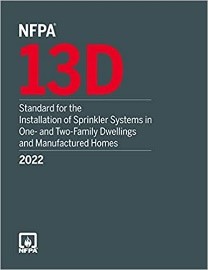Tiny Fires in Tiny Homes: Fires in Manufactured Housing Units

One might assume that the size of a home is a direct indication of survivability from fire. The concept is simple; we can safely egress from smaller spaces, but the reality is many of the fire protection features found in larger or more crowded spaces are not applicable to these smaller spaces. This means no fire sprinklers systems, passive fire protection or even early warning systems. That is strange because fires start in the same places regardless of the size of the home and quickly spread toxic gases through the home, no matter the size. In fact, toxic smoke can fill small spaces even faster. The fact that you have only minutes before you are unconscious due to toxic, super-heated gas remains.
The tiny home concept has become a wildly popular option for affordable housing and is starting to be used to address the homeless issue in America. From structures built out of Sea-Land shipping containers to collapsible homes designed for easy shipping, we see them popping up in major cities around the country.
Home Structure Fires
We have known for decades that most residential fires start in the kitchen and cause an estimated 169,400 home fires per year. While kitchen fires are a leading cause of fires in residential homes, smoking is a leading cause of home fire fatalities, causing an average of 600 deaths, 1030 injuries, and $511 million in direct property loss annually.
The fact is most fire fatalities are in home structures and account for three-quarters of all fire deaths in the United States. The National Fire Protection Association’s Research Foundation report on Home Structure Fires, by Marty Ahrens and Radhika Maheshwari, October 2021 (link above), has a glaring omission. The report does not indicate one-or two- family or townhouse residential home size as a factor in the loss of life. The only close comparison was between one- or two- family residential and multifamily structures which are held to different codes and standards requirements.
A Tiny Home Fires in the News
 On March 9th, 2022, the Anne Arundel County, Maryland Fire Department responded to what was reported as a shed fire. On arrival, the department encountered a small two-story house attached to a garage, with fire showing on both floors of the tiny home. The structure was part of a detached two car garage for a 900sf home, which was not involved in the fire. The fire department extinguished the fire in 15 minutes and found a man in the structure that was pronounced dead at the scene. This tiny structure did not have automatic residential fire sprinklers and was not believed to have any smoke alarms.
On March 9th, 2022, the Anne Arundel County, Maryland Fire Department responded to what was reported as a shed fire. On arrival, the department encountered a small two-story house attached to a garage, with fire showing on both floors of the tiny home. The structure was part of a detached two car garage for a 900sf home, which was not involved in the fire. The fire department extinguished the fire in 15 minutes and found a man in the structure that was pronounced dead at the scene. This tiny structure did not have automatic residential fire sprinklers and was not believed to have any smoke alarms.
Codes and Standards

The International Residential Code (IRC) is widely adopted in almost every state in the United States, requiring all new residential homes to have residential automatic fire sprinklers. However, most states continue to reject the adoption of this specific section of the code. The argument used against this minimum fire protection level is always exaggerated cost estimates, and for those tiny homes- they are just too small.
 NFPA 13D Standard for the Installation of Sprinkler Systems in one-and Two-Family Dwellings and Manufactured Homes has continued to try and address the installation requirements for residential automatic fire sprinkler installations in these tiny structures, adding new language in the latest 2022 edition addressing tiny houses.
NFPA 13D Standard for the Installation of Sprinkler Systems in one-and Two-Family Dwellings and Manufactured Homes has continued to try and address the installation requirements for residential automatic fire sprinkler installations in these tiny structures, adding new language in the latest 2022 edition addressing tiny houses.
Federal Emergency Management Agency (FEMA)
FEMA required all Manufactured Housing Units (MHU’s) used for disaster emergency housing to be equipped with residential automatic fire sprinkler systems since 2016. These trailers, 250sf – 300sf, are fully compliant with the U.S. Department of Housing and Urban Development (HUD) codes and include NFPA 13D residential automatic fire sprinkler systems. Research has shown that fire sprinklers, combined with early warning smoke alarms, reduce fire fatalities in a residential home by more than 82%. This is a clear statement that not only do residences with fire sprinklers provide a safe place to live, but FEMA is also committed to providing that minimum code level of safety to those most at risk after disasters.
The fact that we often use this tiny model for affordable or disaster relief emergency housing does not mean it should be unsafe housing. We must continue to help protect the most vulnerable population. The minimum safety standard provided by residential automatic fire sprinkler systems should not be omitted.
The National Fire Sprinkler Association is Your Premier Resource for Codes and Standards Updates
The National Fire Sprinkler Association’s (NFSA) Codes, Standards and Public Fire Protection Team is the best resource for all codes and standard updates surrounding fire protection. Team members sit on numerous NFPA technical committees and vote on changes that create a safer world.
For more information on the NFSA, or to become a member of our association, visit our membership page.
